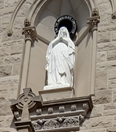Blog:Separation from God: free will, sin and willful damnation
Then Jesus straightened up and said to her, “Woman, where are they? Has no one condemned you?” She replied, “No one, sir.” Then Jesus said, “Neither do I condemn you. Go, from now on do not sin any more.” (Jn 8:11)
As across Salvation History, here we have the blessing and the correction -- called a "curse" in the Old Testament: "Go, from now on do not sin any more."
There has been much wonder and academic debate over this passage. Scholars say it was added to the Gospel of John well after its writing , and is thus inauthentic. Others say it was in the original manuscripts but dropped for a time for fear that the passage legimized adultery. There is no mistaking that the passage reflects the authentic Christ: repent, and believe (Mk 1:15)
As with other encounters with the living Christ, we cannot help but wonder what happened to this woman afterward. Like the Leper, the Woman at the Well, the Tax Collector, we can only hope and pray they sinned no more.
The wondedful part of this story is there is no miracle -- wait, there is, belief. Blessed are those who have not seen yet believe.

